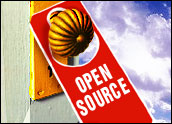
Despite its increasing use on enterprise servers and on company desktops, the Linux OS is perhaps moving fastest in the mobile space.
There are challenges, though, as well as many possibledirections for mobile Linux, raising the prospect of fragmentation.
LinuxInsider spoke with a la Mobile CEO Pauline Alker regarding the market landscape and the different directions Linux can take in the mobile space.
LinuxInsider: How does the market for mobile Linux look currently?
Pauline Alker: Mobile Linux is one of the fastest growing markets andhas the potential to be the largest segment in Linux. With literallybillions of mobile devices in the market, Linux on mobile could outstripboth Linux-based desktops and servers combined. In addition, by allaccounts, Linux is growing in market share in mobile by displacing theproprietary operating systems like Symbian and Microsoft.
LI: Discuss what you see as the biggest mobile Linuxstrategies currently in the mix?
Alker: It seems to me that there are two strategies currentlybeing applied to mobile Linux, which point to an opportunity for a thirdthat we are pursuing. These two are the traditional embedded RTOS playand the platform lock-in play.
The embedded software world is used to a number of players providingkernel technology and tools that can then be integrated into a number ofproducts.
Any required technology in addition to the kernel needs to beassembled by the OEM from an ecosystem of partners that the embeddedRTOS (real-time operating systems) vendor works with and supports. This is a great strategy for closedenvironments where the technology must be tailored to each device. Thishas worked quite well in the context of mobile devices where the devicereally only had to be phones.
The problem with an embedded RTOS strategy is that manufacturers needa more complete solution. The complexity of the required platform, notto mention the operator testing and interoperability requirements, hasreached the point where it is no longer reasonable for the manufacturersto provide the complete software integration and support themselves.They need a third party to do it.
The other strategy often acknowledges the importance of a completesolution and in many cases offers it, but does so at the cost ofplatform lock-in. These companies offer to support a Linux platform butinclude their own proprietary technology — usually focused on the userinterface toolkit and a collection of applications.
The goal is to gainenough market share to draw developers to the platform, often growing tothe point where the volume of applications on the platform makes it theonly relevant choice in the market. This is similar to the strategy thatMicrosoft has had on the desktop for all these years.
The lock-in strategy is attractive for the owner of the platform ifit can be made to work, but it faces some interesting challenges. First,neither operator nor OEM wants to see a replay of the PC market in themobile space. A single operating platform control point inhibitsinnovation and increases costs.
Secondly, there is no reason for such acontrol point to exist. Technologies like Java, Flash, SVG and Web 2.0browser technologies continue to show that many of the services userswant can be expressed in these.
As these technologies get morecapable, they are likely, in classic “innovator’s dilemma” fashion, todisrupt the proprietary, native application environment. Thus, thevalue of the proprietary native application framework is diminished incomparison to the PC.
In contrast, a la Mobile is pursuing a strategy that will split thedifference. We are listening carefully to the customers’ desire to havea complete solution and are providing it with our Convergent LinuxPlatform.
Perhaps most importantly, however, we have no vested interest in thesuccess of one particular platform component over another. Indeed, weare perfectly comfortable in supporting any of a variety of userinterface technologies or application sets as determined by theoperator, the OEM or the overall market.
Traditionally, the OS is a fairly monolithic collection oftechnologies, tightly integrated, where separation is not easily achieved.If you want to replace the browser that ships with the OS, it’s notlikely to be possible. We think that the opportunity exists to satisfythe market for a mobile operating system platform — by being willing tobuild what the customer needs and determines is in their best interest,as opposed to telling them what is in their best interest and onlyproviding that. It’s a unique view point, I think.
LI: Why is Linux good for the mobile setting?
Alker: Technically, Linux is probably the best solution for amodern operating system available on small devices today. It has all ofthe features necessary for the increasing capability of the devices, andbecause of some of the great work done in the past five years by a fewtrue innovators, it has the ability to run extremely well in the memoryconstrained, power-conscious world of embedded devices.
Because Linux is an open source technology, it is ideally suited to amarket that does not want to be held captive by a single provider. Thislends itself to all kinds of positive market dynamics. Competitors canbe admitted far more easily than in the proprietary-kernel case. Thatmeans demand for increased ability to brand the device through softwareis more likely to be addressed; it also means that prices are not likelyto get outrageous.
LI: What are the challenges for Linux when it comes tothe mobile market?
Alker: One well known challenge is the issue of platformfragmentation. This issue is being solved by the ongoing work done instandards committees like OSDL’s MLI (Mobile Linux Initiative) group and the LiPS (Linux Phone Standards) group. Clearly,we need a set of base APIs (application programming interfaces) that are available in the device.
LinuxInsider: What impact is mobile Linux having on otherplatforms that play in the market?
Alker: It’s helping to rationalize the playing field. Theentire industry is beginning to see it is possible to have a viablemobile operating system supporting a variety of compelling services notowned by a single company. For those platforms that fit naturally intoan ecosystem that includes Linux — such as Java, Flash and the otherapplication platforms — it is only increasing their importance and reach.For the other platforms, Linux seems to be taking market share fromthem.
LI: Where do most handset makers stand on Linux?
Alker: All OEMs that we talk to are either putting Linux intothe marketplace, have projects to do so, or in some limited cases areinvestigating how to begin Linux projects.
LI: What about mobile applications — is this a barrierfor mobile Linux?
Alker: I really don’t think so. Because our platform supportsJava and Flash Lite, we have access to an incredible number of relevantmobile applications out of the box. In addition, the Linux developercommunity is quite large and we’ve had no trouble getting theapplication support we need. Also, as mobile Linux continues to grow, wewill see more open source projects begin to develop.
In my 40 years as an entrepreneur, I don’t think I’ve ever seen suchan incredible opportunity for so many. The combination of Linux andmobile handsets is very likely going to revolutionize the softwareindustry.

















































